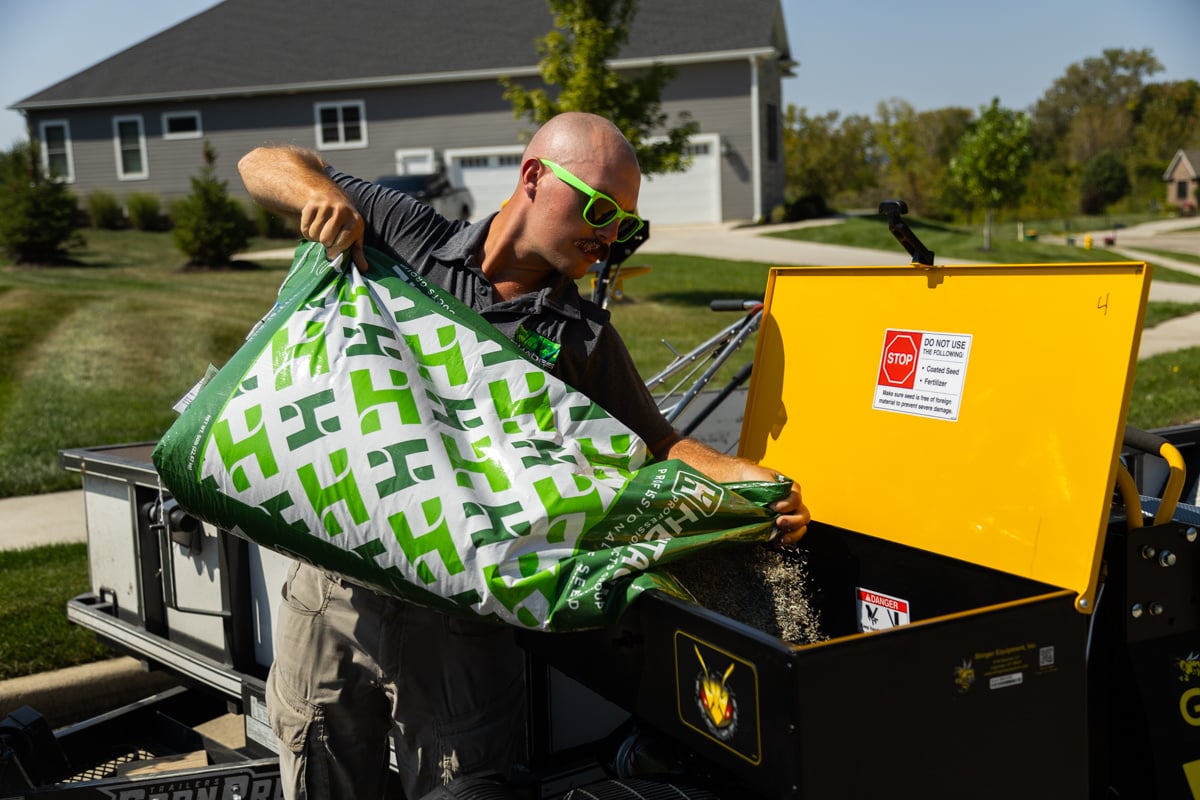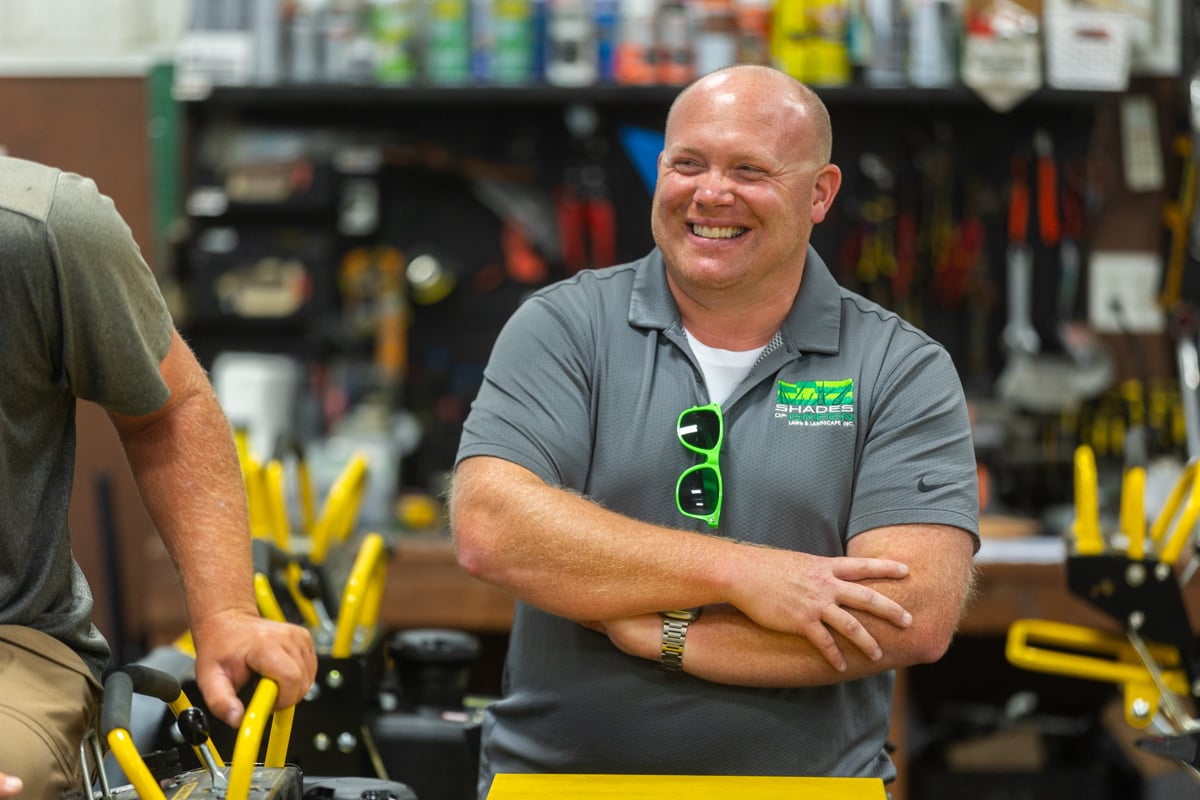
The Secret to a Thicker Lawn: When to Plant Grass Seed in Indiana

Planting grass seed is like baking the perfect pie – timing is everything. And if you’re in Indiana, you’ve got two windows to work with: spring and fall. But when is the best time of the year to plant grass seed? The short answer is between August 15th - September 15th.
Why does timing matter so much? Because the success of your grass seed depends heavily on the conditions it faces right after planting. The right timing ensures your lawn gets the ideal combination of soil temperature, moisture, and growth potential.
Plant too early or too late, and you risk wasting your seed – and your time.
Let’s explore the common misconceptions around seeding in the spring in order to uncover why late summer and early fall are prime times for a thicker, healthier lawn.
When to Plant Grass Seed in Indiana
When thinking about the best time of the year to plant grass seed, spring seems like the obvious choice, right? April showers, May flowers, all that good stuff. Well, not so fast. While spring brings plenty of rain (and then some here in Indiana), it also comes with a few curveballs that make planting grass seed a bit of a gamble.
Rain: From Friend to Frenemy
Spring rains here in the Lafayette area are statistically abundant, which is great – except when they decide to show up as heavy downpours instead of gentle, grass-nurturing sprinkles. Your carefully planted seeds can wash away faster than your patience when you realize you’ll have to reseed in the fall.
Soil Temperatures: The Waiting Game
Grass seed germinates best when soil temps are between 55-60 degrees. In Indiana, that sweet spot doesn't reliably hit until May. Even then, spring temperatures can yo-yo between “yay, germination!” and “oops, never mind,” making it really tough for seeds to get a consistent start. Baby grass gets stressed extremely fast, and poor soil temperatures can cause excessive growth or kill off new seedlings before they even have a chance.
Weeds, Weeds, Weeds
Spring grass seedlings come with an open invitation to crabgrass and other problematic weeds. Plus, you can’t use your normal crabgrass pre-emergent control without sabotaging your grass seeds. So now, you’re stuck babysitting your new grass while also dealing with relentless weed pressure.
High Maintenance, Meet High Stress
Spring-seeded lawns are like needy houseplants. They require constant care – spoon-feeding nutrients, extra watering, and dodging fungal diseases that thrive in wet, stressed-out conditions. By the time summer hits, that baby grass is just not ready to face the Indiana heat.
Why Fall is the True MVP for Grass Seeding
Let’s be honest: fall is where the magic happens. Specifically, the golden window for when to plant grass in Indiana is from August 15 to September 15. Here’s why this season is your best bet for achieving that lawn that makes your neighbor green with envy.
Water Control is in Your Hands
Statistically, fall is drier than spring, which means you’re not relying on Mother Nature’s unpredictable mood swings to water your lawn. Instead, you can control the watering schedule, giving your grass exactly what it needs to thrive.
Perfect Temperatures, Happy Seeds
In the fall, the soil temperature is still warm enough for quick germination, but the air is starting to cool down. This combination is a dream come true for cool-season grasses, the variety we use here in Indiana, which thrive in these types of conditions. Plus, our treated seeds can start sprouting in as little as 4-6 days.
Fewer Weed Wars
Unlike spring, the fall doesn’t come with a weed invasion. By this time of year, crabgrass and other troublemakers are waving their white flags, leaving your grass seed to grow without constant competition - at least until next season.
Built-In Resilience for Next Summer
Cool-season grasses seeded in the fall have one major advantage: time. They get a whole season to establish strong roots and store energy before winter dormancy. When spring rolls around, they’re already ahead of the game, ready to tackle summer’s heat with less watering, fewer diseases, and more strength.
How Regular Seeding Benefits Your Lawn
Think of regular grass seeding as your lawn’s gym membership – it keeps everything in shape, fills those patchy “problem areas”, and helps your turf stay strong against whatever Mother Nature throws its way. Here’s why making seeding part of your routine is a total game-changer.
Repair Patches and Keep it Lush
Let’s face it – bad patches happen. Whether it’s from heavy foot traffic, a particularly harsh season, or Fido’s “favorite spot”, your lawn can take a beating. That’s where regular seeding swoops in to save the day. By overseeding, you’re filling in those bare or thin spots, making your lawn look even and pristine again.
And even if your lawn is already looking fabulous, we still recommend lightly overseeding. Why? Because grass seed, like everything else, has come a long way over the years.
The Power of New Genetics
Grass seed planted 10 years ago isn’t the same as what’s available today. The latest seed blends are packed with all the modern upgrades: darker green grass, better disease resistance, and stronger roots. Regular overseeding introduces these new genetics into your lawn, making it healthier and more vibrant. Consider it as keeping your lawn trendy and resilient – like upgrading from flip phones to smartphones.
When you buy a bag of grass seed, it contains a blend of multiple grass species and subspecies, or cultivars. The typical branded bag from the big-box stores will feature one or two cultivars that perform well and the rest just act as filler - with luck, 50% will survive. At Shades of Green, we create our own blend of rockstar cultivars from multiple brands resulting in a premium seed mix made 100% of grasses we know work for our area to germinate and establish faster.
The Deal with Turf Type Tall Fescue
If your lawn features tall fescue, which most lawns do in Indiana, here’s the deal: it’s a bunch grass, not a spreading grass. This means it doesn’t heal itself or spread to fill in bare spots on its own. You’ve got to lend it a helping hand with some good old-fashioned seeding. When you do, tall fescue rewards you with one of the toughest, most durable lawns out there.
The Best Weed Control? A Dense Lawn
Weeds hate competition, and nothing competes better than a thick, healthy lawn. By overseeding regularly, you’re giving your lawn the upper hand. The denser the grass, the less space weeds have to grow, and the fewer chemicals you’ll need to keep them in check. It’s the ultimate win-win for you and your yard.
Partnering with Shades of Green for Overseeding in Lafayette, IN or North Indianapolis Suburbs
Timing is everything when it comes to planting grass seed, and as we’ve explored, fall is the clear winner here in Indiana. While spring may seem tempting, the risks of heavy rains, fluctuating soil temperatures, aggressive weed growth, and high maintenance requirements make it less than ideal.
Regular overseeding is the key to a dense, healthy lawn that can outcompete weeds, pests, and disease while staying lush and vibrant. Plus, introducing modern grass seed genetics ensures your lawn benefits from improved disease resistance, richer color, and stronger roots. If you want your lawn to look its best, Shades of Green is here to help with top-notch seed blends and expert lawn care advice tailored to Indiana’s unique conditions. Let’s get started on creating the lawn of your dreams!
If you want your lawn to look its best, Shades of Green is here to help with top-notch seed blends and expert lawn care advice tailored to Indiana’s unique conditions. Let’s get started on creating the lawn of your dreams!
Searching for lawn care in Lafayette and Nearby Areas? We also provide services in Carmel, Noblesville, & Westfield. Get started today by filling out our contact form.
About Cory Overman

Cory is the heart and soul of Shades of Green. His dedication to doing right for our customers has been the driving force behind the company's success. With a degree in Turf Science from Purdue University, Cory continually strives to craft the best treatment plans using the latest technologies and innovative products, ensuring top-notch results for every client.
